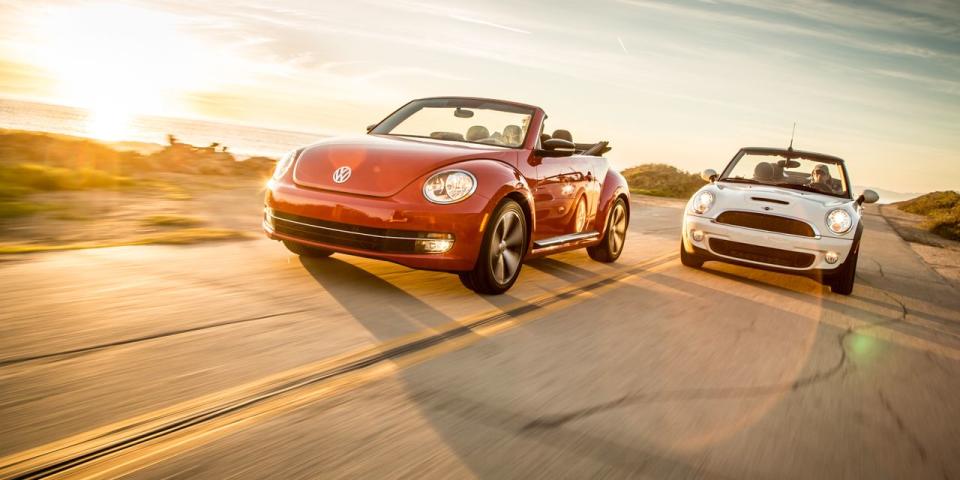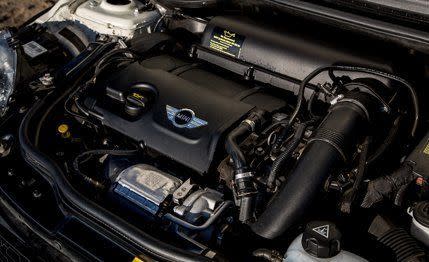2013 VW Beetle Turbo Convertible vs. Mini Cooper S Convertible

From the April 2013 Issue of Car and Driver
TESTED
The Volkswagen Beetle Turbo and the Mini Cooper S convertibles are built for the fashionable, for people who know they look great in linen pants and that denim makes their butts seem huge. They can tell a genuine Barcelona chair from a knockoff at 60 yards. Style counts. So does cute. Performance? Utility? Not really.
But must fashionistas suffer to be chic? Both the Mexican-made Beetle and the Brit-built Mini convertibles are compromised by their self-conscious designs. They’ve got tiny, nearly useless trunks. Big, fluffy-white Samoyeds may look stunning sitting in the open air on either of the cars’ rear seats, but human beings will be cramped. When the tops are up, an entire Lululemon store could hide in their blind spots, but neither car is available with a rearview camera. In each, there are elements that may initially seem like sweet eccentricities but become irritating affectations in daily use. And all that’s above and beyond the extra weight and compromised structure inherent in virtually every convertible.

Prices for this pair start within an eyelash extension of one another. The Beetle Turbo convertible begins at $28,590, the Cooper S convertible at $28,850. The suite of totally adorable options added to each brought MSRPs up to $31,990 for the VW and $34,350 for the Mini.

The butched-up, second generation of the revivified Beetle may have been new in 2012, but it’s all last-generation Golf underneath. That means a transverse-mounted engine driving the front wheels and a strut-type front suspension—basically, Golf specs since 1974. All versions of the 2013 Beetle convertible borrow the multilink rear suspension from the Golf, essentially the same one that is used only in turbo-model Beetle coupes. Further, VW says that the basic unibody structure has been stiffened by 20 percent to yield a natural frequency of 17.8 Hz, which means that if a shaman of pure spirit hums loudly at exactly that frequency, the car will levitate.*
There aren’t many surprises in the Mini Cooper S convertible’s engineering, either. Check off the same boxes for the transverse engine, the front struts, and the multilink rear suspension. But the Mini Cooper S is smaller. At 146.8 inches in overall length, it’s 21.6 inches shorter than the Beetle, and at 66.3 inches wide, it spreads out 4.9 fewer inches. Yet the Mini’s 97.1-inch wheelbase is only 2.9 inches behind that of the VW’s, so the wheels are pushed out to the car’s far corners. Most critical, the Mini weighs 480 pounds less than the Beetle.

This test Beetle had VW’s ubiquitous 200-hp, 2.0-liter turbocharged four in its bulbous Shamu nose. The Cooper S uses a turbocharged 1.6-liter four rated at 181 horsepower. Both ran six-speed manual transmissions, because there’s only so far we’ll compromise for this job. A conventional six-speed automatic is optional in the Mini, and the VW can be had with a dual-clutch six-speed automatic.
Of course, convertibles need to be judged by their own standards. And sunshine, lollipops, and rainbows aren’t compatible with carrying lumber home from Lowe’s. Speed and handling matter, just not as much as comfort and an easygoing, happy personality. If ultimate performance is your goal, get the closed-roof version every time.
Then sign up for a spinning class. You need the cardio.
*Test pending. Sherman went missing.
More Pilates instructors than slalom aces may buy the Cooper S convertible, but it’s almost admirable how Mini has held fast to the company’s performance ideals in tuning this car. Almost. The suspension is so beyond stiff that it feels petrified. The engine rips, snorts, and barks as the driver slams through six closely spaced gears. But even in the overdriven sixth, it never calms down. The electric-assisted rack-and-pinion steering runs a quick 14.1:1 ratio and transmits every road hiccup directly to the hands clenched around the thick steering-wheel rim. Turn the traction control off, and there are few more mechanically involving cars.
The Cooper S is quick enough, certainly among cars apt to be called “cute.” It sprints from zero to 60 mph in 6.7 seconds and knocks off the quarter-mile in 15.1 seconds at 93 mph. The power delivery is seamless, and there’s enough mid-range torque to be forgiving of gear-selection screw-ups. Turbo lag is nonexistent.

Even though 60 percent of its weight is on the front wheels, the Cooper’s understeer is only moderate on the skidpad, where it orbits to 0.90 g. And it screamed through the slalom at 43.7 mph, 3.6 mph quicker than the Beetle.
The problem: All that hard-core performance tuning is stuck in a soft-core convertible body. The cowl reverberates over even minor road divots as if its molecules were at war with their own atoms. When the nose digs into a corner, the tail feels as if it’s trying to twist away from doing its work. The whole structure seems tuned to report back with Dolby Digital clarity any noise made by the 205/45R-17 Bridgestone Potenza RE050A tires. Throw in the sound coming from air rushing over the single-layer top, and the result is sensory overload. This car can be as excruciating as a full leg waxing.
The convertible top has its attractions. The front portion opens to function as a sunroof. It latches with the movement of a single toggle switch. And when the top is down, the Mini looks delicious.

The interior, however, goes wildly goofy. The giant speedometer at the dash center looks like a produce scale in a Brooklyn bodega, and it’s redundant anyhow, since the driver has a digital speedometer embedded in the tachometer directly ahead. An “Openometer” alongside the tach tells the driver how long the top has been down. Perhaps this bit of dermatological whimsy is vital in fair-skinned England, but it comes at the expense of oil pressure, turbo boost, and ammeter gauges. Other oddball elements elevate the frustration level, such as seat recline handles awkwardly buried inboard of the cushions, and the oddly caged toggle switches.
But when all the shouting is over, there’s nothing about this Mini Cooper S that a fixed roof wouldn’t make better.
Despite a big rear spoiler that’s a sneeze guard away from being a buffet table, the worst thing about the Beetle Turbo convertible is that it isn’t a GTI convertible. But it’s a better convertible than the Cooper S.
The Beetle’s top is thick and multi-layered, an effective barrier against the intrusion of wind, water, and whatnot. Cut it off the car, and it could be used as an emergency yoga mat. It quickly latches, it quickly unlatches, and it folds down with the touch of one button but still sticks up above the body. What’s more, it can be opened with the car moving at speeds up to 31 mph, according to VW. Daringly, we pushed it to 32 and it still worked. And with the optional wind blocker in place, it’s even possible to converse at normal volumes.
Inside, the Beetle dash draws inspiration from its air-cooled ancestor with its cowled instrument cluster. Its flat face is covered in fake carbon fiber, with three subsidiary gauges—oil temperature, boost pressure, and a nearly useless stopwatch, perhaps for fair-skinned Germans—in a cluster atop the dash center. The grapefruit-sized speedometer under the cowl is framed by a tangerine-sized tachometer on the left and an equally fruity fuel gauge on the right. No one needs a fuel gauge this freakishly big. VW should have made the tach and speedo the same size and shoved a smaller fuel gauge in between them.

VW fills a large hole in the dash center with an optional, small touch-screen navigation system, but overall the Beetle interior isn’t nearly as compromised by its fidelity to trendiness as is the Mini’s.
More softly sprung than the Cooper S, the Beetle Turbo doesn’t challenge its structure in the same way, either. There’s some cowl shake, but the car retains its dignity and comfort. The prices for that are low levels of grip and modest handling scores.
The Beetle Turbo’s 200-hp, 2.0-liter iron-block four makes a distinctly nasal sound, but it still delivers the solid low-end torque that’s been its hallmark in Audis and VWs. The VW’s 6.8-second traipse from zero to 60 mph and the 15.3-second quarter-mile at 92 mph are only slightly behind the Mini’s. However, the Beetle Turbo needs 15.2 seconds to accelerate from 30 to 50 mph in top gear, or more than twice what the Mini needs. In contrast, and though it shares an engine with the GTI, the hatchback uses a transmission with more-closely spaced ratios and with only sixth as an overdrive. Consequently, the 259-pound-lighter GTI does zero to 60 in 6.4 seconds and needs only 10.2 seconds to run from 30 to 50.

Relying on 235/45R-18 Hankook Optimo H426 all-season tires, the Beetle squirms a bit before taking a set through tighter corners. It then determinedly pushes its nose. The steering is sweetly weighted and nicely communicative, but there’s a better balanced car in here looking to get out.
There’s fun to be had with the Beetle, though we think VW should have started with the GTI’s much better transmission and suspension tuning and tweaked from there. In fact, there is a similarly equipped Beetle TSI available in Europe, so the parts are already on the shelf. Meanwhile, the Beetle is still striving for the Nobel Prize for retro cuteness and doing it with relaxed aplomb.
You Might Also Like

 Yahoo Autos
Yahoo Autos 